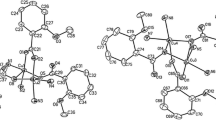Abstract
A single crystal calorimetry of a heptacopper(II) complex of [Cu7(μ3-Cl)2(μ3-OH)6-(d-pen-disulfide)3] which has a double-cubane structure supported by d-penicillaminedisulfides has been performed at low-temperature region below 8 K. This compound is a metal complex which contains seven Cu(II)s in a cluster unit. These Cu(II)s are magnetically coupled each other by strong intra-complex interactions. The heat capacities under magnetic fields exhibit Schottky type anomalies explained by the Zeeman splitting of the doublet ground state of the complex. The g-value of the ground state is evaluated as 1.86 from the systematic analysis of the Schottky peak under magnetic fields. The first excited state of the cluster seems to be separated at least by several Kelvins, which is consistent with the theoretical calculations and magnetic susceptibility results.





Similar content being viewed by others
References
Christou G, Gatteschi D, Hendrilson DN, Sessoli R. MRS Bull. 2000;25:66.
Gatteschi D, Sessoli R. Quantum tunneling of magnetization and related phenomena in molecular materials. Angew Chem Int Ed. 2003;42:268–97.
Coronado E, Palacio F, Veciana J. Molecule-based magnetic materials. Angew Chem Int Ed. 2003;42:2570–72.
Yoshizawa H, Kazama C, Awaga K, Satoh M, Wada J. Rechargeable molecular cluster batteries. Chem Commun 2007; 3169–70.
Kirn J, Rees DC. Crystallographic structure and functional implications of the nitrogenase molybdenum–iron protein from Azotobacter vinelandii. Nature. 1992;360:553–60
Igashira-Kamiyama A, Fujioka J, Mitsunaga S, Nakano M, Kawamoto T, Konno T. A new class of hydroxo-bridged heptacopper(II) clusters with an acentrosymmetric corner-sharing double-cubane framework supported by D-penicillaminedisulfides. Chem Eur J. 2008;14:9512–5.
Sorai M, Nakano M, Miyazaki Y. Calorimetric investigations of phase transitions occurring in molecule-based magnets. Chem Rev. 2006;106:976–1031.
Sorai M, editor. Comprehensive handbook of calorimetry and thermal analysis. Chichester: Wiley and Sons; 2004.
Nakazawa Y, Kawamoto A, Kanoda K. Characterization of low-temperature electronic state of the organic conductors alpha-(BEDT-TTF)2MHg(SCN)4 by specific-heat measurements. Phys Rev. 1995;B52:12890–4.
Yamashita S, Hino K, Inoue Y, Okada Y, Hirahara R, Nakazawa Y, et al. Calorimetric study of molecular superconductor κ-(BEDT-TTF)2Ag(CN)2H2O which contains water in the anion layers. J Therm Anal Calorim. 2008;92:435–8.
Yamase T, Ishikawa E, Fukaya K, Nijiri H, Taguchi T, Atake T. Spin-frustrated (VO)3 6+-triangle-sandwiching octadecatungstates as a new class of molecular magnets. Inorg Chem. 2004;43:8150–7.
Rousochatzakis I, Ajiro Y, Mitamura H, Kogerler P, Luban M. Hysteresis loops and adiabatic Landau-Zener-Stückelberg transitions in the magnetic molecule {V6}. Phys Rev Lett 2005; 94, 147204 1–4.
Author information
Authors and Affiliations
Corresponding author
Rights and permissions
About this article
Cite this article
Tokoro, N., Yamashita, S., Igashira-Kamiyama, A. et al. Low-temperature heat capacity of heptacopper(II) complex [Cu7(μ3-Cl)2(μ3-OH)6-(d-pen-disulfide)3]. J Therm Anal Calorim 99, 149–152 (2010). https://doi.org/10.1007/s10973-009-0514-5
Published:
Issue Date:
DOI: https://doi.org/10.1007/s10973-009-0514-5




